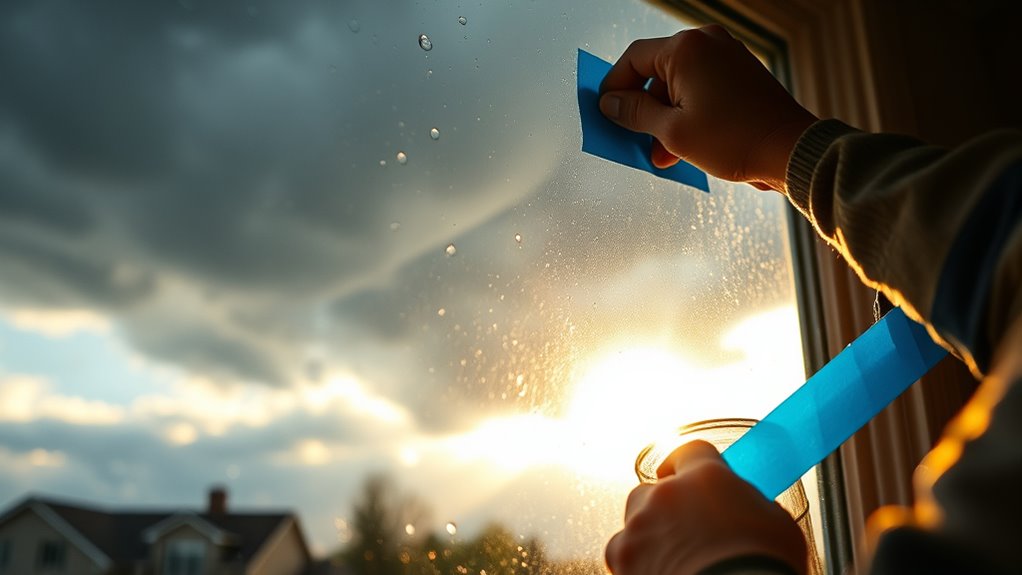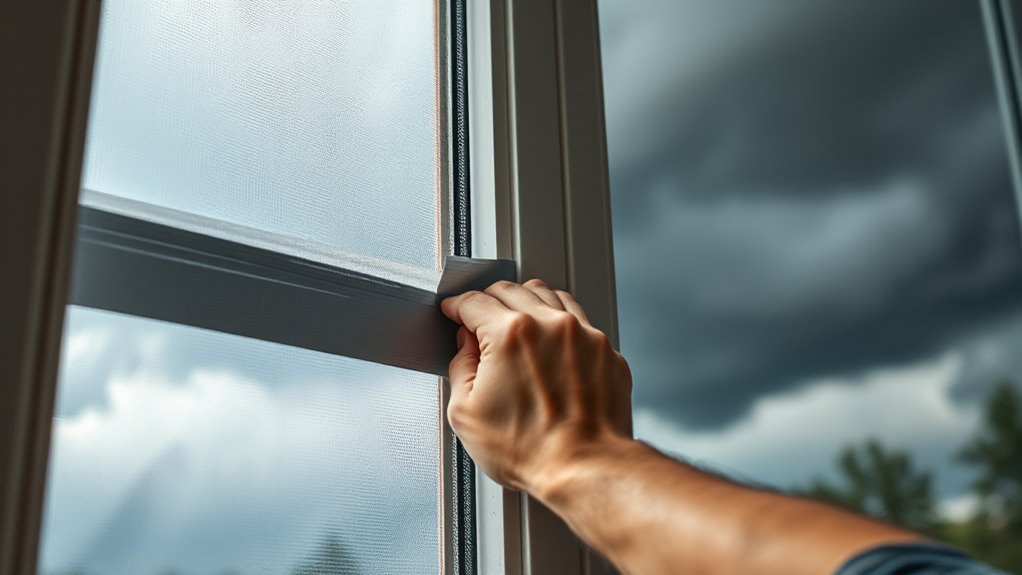To weatherproof your windows before a storm, start by inspecting for cracks, gaps, or broken seals and repair any damage. Seal around the frames with weatherstripping or caulk to prevent drafts and leaks. Install storm shutters or use plywood panels for added protection, ensuring they’re secured tightly. Reinforce glass with impact-resistant film, and clear the area of loose items and debris. Taking these steps will help safeguard your home—keep going to learn more tips to stay prepared.
Key Takeaways
- Seal gaps around window frames with weatherstripping or caulk to prevent drafts and water infiltration.
- Install storm shutters or temporary coverings like plywood or heavy-duty plastic for impact protection.
- Repair and reinforce any existing window damage or cracks to enhance resilience against storm forces.
- Apply impact-resistant film or safety glass to reduce shattering and contain broken glass during high winds.
- Clear surrounding area of loose outdoor items and debris to prevent projectiles from damaging windows.

Are your windows prepared to withstand harsh weather conditions? If a storm is approaching, it’s vital to verify your windows are ready to protect your home. Strong winds, heavy rain, hail, and flying debris can cause considerable damage if your windows aren’t properly fortified. Taking the time now to weatherproof your windows can save you money, stress, and potential property damage down the line.
Start by inspecting your windows thoroughly. Look for any cracks, gaps, or broken seals that might let water or wind seep inside. If you notice any damage, consider repairing or replacing the affected panes before the storm hits. Small cracks can quickly turn into larger problems under pressure, so don’t delay fixing them. Once you’ve addressed any existing issues, focus on sealing gaps around the window frames. Use weatherstripping or caulk to fill in leaks around the edges. This step is vital because even tiny openings can let in drafts, moisture, and debris during a storm.
Inspect windows for cracks or gaps; repair or seal to prevent storm damage.
Next, consider installing storm shutters or temporary protective coverings. Storm shutters provide a sturdy barrier against flying debris and can be quickly deployed when bad weather is forecasted. If permanent shutters aren’t an option, you can use plywood panels or heavy-duty plastic sheeting as temporary shields. Measure your windows precisely to cut the panels to size, then secure them tightly using screws or fasteners. Make sure these coverings are easy to remove once the storm passes, and double-check they’re firmly attached to prevent them from coming loose during high winds.
Another effective step is to reinforce the glass itself. If your windows have double-pane or energy-efficient glass, verify they are in good condition. For added protection, some homeowners install impact-resistant film or safety glass, which can hold broken pieces together if hail or debris shatters the window. Applying a clear, adhesive window film can also minimize shattering and contain broken glass, reducing the risk of injury and further damage. Additionally, weatherproofing materials like window film and impact-resistant coatings can greatly improve your windows’ resilience against storms.
Finally, don’t forget to clear the area around your windows. Remove loose outdoor items like furniture, tools, or hanging plants that could become projectiles during strong winds. Trim back trees and bushes to reduce the risk of branches crashing into your windows. By taking these proactive steps, you’ll greatly improve your home’s resilience against the storm, giving you peace of mind knowing your windows are as prepared as possible. When the storm hits, you’ll be glad you invested time in weatherproofing now.
Frequently Asked Questions
How Often Should I Inspect My Window Seals?
You should inspect your window seals at least once a year, preferably in the spring or fall. Check for cracks, gaps, or deterioration that could let in moisture or drafts. After severe storms or high winds, quickly examine the seals for damage. Regular inspections help you catch issues early, ensuring your windows stay weatherproof and energy-efficient. Don’t forget to reseal or replace damaged weatherstripping whenever needed.
Can Weatherproofing Damage Existing Window Frames?
Weatherproofing generally won’t damage your existing window frames if you choose the right materials and apply them correctly. You should guarantee that you’re using compatible sealants or weatherstripping designed for your window type. Proper installation is key, so follow manufacturer instructions carefully. If you’re cautious and do thorough research, you can weatherproof your windows without risking damage, making your home more protected during storms.
What Is the Best Time of Year to Weatherproof Windows?
You should weatherproof your windows in early fall or late spring, when the weather’s mild enough to avoid sweating over frozen or overheated surfaces. Imagine trying to seal a window in a heatwave—your sweat’s just not aiding. Doing it during these shoulder seasons ensures you get a snug fit, avoiding the chaos of stormy weather while you’re at it. Plus, you won’t be battling Mother Nature’s mood swings.
Are DIY Weatherproofing Methods Effective Long-Term?
DIY weatherproofing methods can be effective long-term if you take the time to do them right. You’ll want to regularly inspect and maintain seals, caulking, and weatherstripping to guarantee they stay intact. While DIY fixes save money, they might not last as long as professional solutions. However, with proper upkeep and attention, your efforts can considerably improve your windows’ durability and help protect your home over the years.
How Do I Choose the Right Weatherproofing Materials?
You should choose weatherproofing materials based on your window type and climate. Look for durable, weather-resistant options like rubber, foam, or caulk designed for outdoor use. Consider ease of application and whether the material provides a good seal against drafts and moisture. If you live in a harsh climate, invest in high-quality sealants or weatherstripping. Always match the material to your window’s material and your specific weather conditions for best results.
Conclusion
By weatherproofing your windows now, you’re protecting your home and loved ones from the storm’s worst. Some might think it’s unnecessary or too much effort, but trust me, a small prep now can save you big headaches later. Don’t wait until the last minute—taking these simple steps guarantees peace of mind when the weather turns fierce. Stay ahead, stay safe, and face the storm with confidence.









